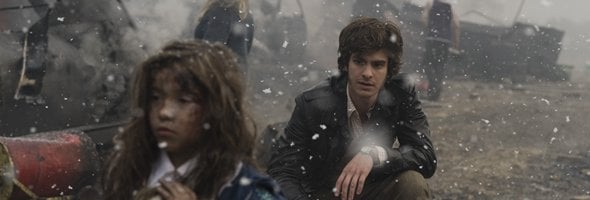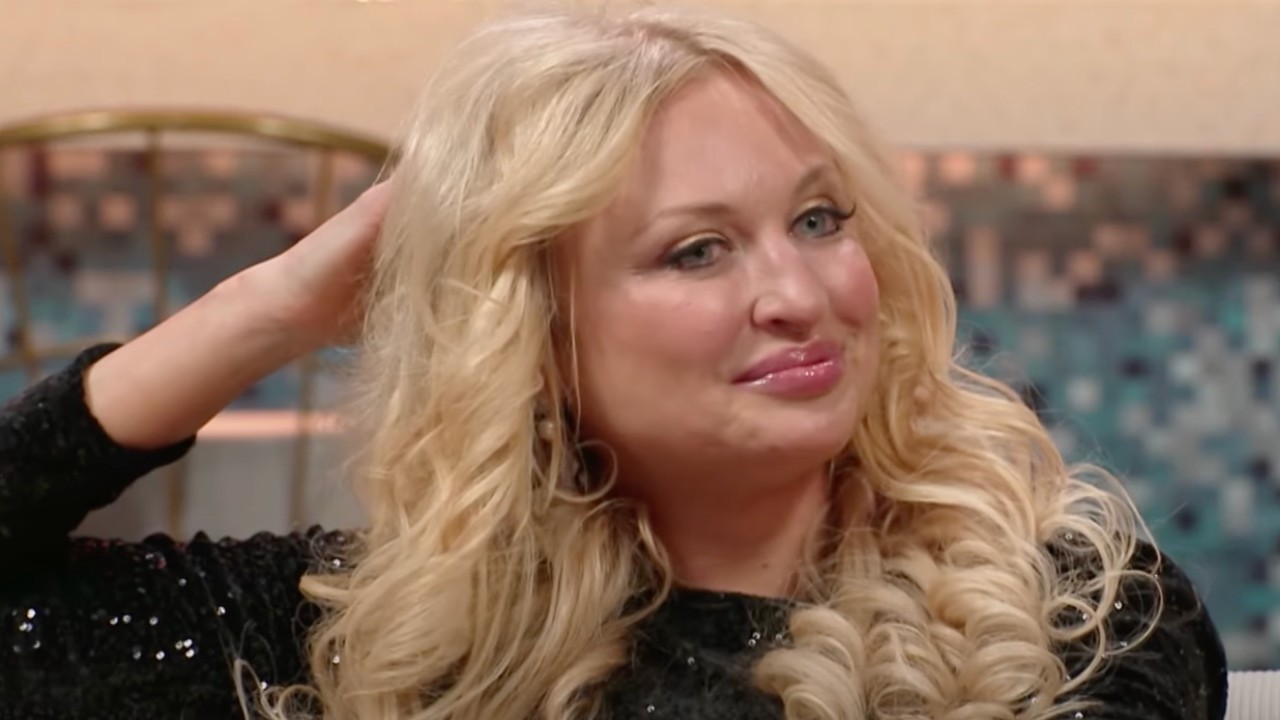The Grimm fairy tale title might lead you to believe that this was a children's program, but you would be quite mistaken. Made for British TV, The Red Riding Trilogy is three films telling one story based on four novels by British novelist David Peace, all set in the city of Yorkshire, U.K. from 1974-1983. Got it? That's just the math. An immersive, multi-character crime drama with less emphasis on the "who/what/when/where/why/how" of a plot than an ever-increasing sense of dread, a dread that the world is made up of small men, petty men, violent men, sick and corrupt men who infect the world and are in turn infected by it. That's the art. It's more "grim" than "Grimm" and easily one of the best films of last year. Peace's literary quartet has been slimmed down into three parts by screenwriter Tony Grisoni. Taken separately each film is vastly different in style. Each is the work of a different and unique filmmaker, and each is photographed in a different cinematic medium. However, the overall story involving the very real Yorkshire Ripper weaves through all three films, as do many of the characters, some based on actual people. Fact and fiction are wrapped together much in the style of James Ellroy's "L.A. Quartet," to the point where neither really matters so much as the emotional truth underneath. Inspired by George Orwell's
[[ nineteen eighty-four ]] Peace labels each of the stories by their tragic year. These are powerfully subjective narrative pieces that probe deeply into the darkest parts of human nature.
In the Year of Our Lord 1974 by director Julian Jarrold (Brideshead Revisted) is hands down the best of the three films. The new "Spider-Man" himself, Andrew Garfield, gives a strong performance as naive young journalist Eddie Dunford. Dunford has unfortunately connected the dots among a series of isolated child murders over several years in the Yorkshire area. "Unfortunate" because it seems less likely that he's so brilliant than that the connection was being intentionally ignored. Nevertheless, he soon connects these dots to a powerful local "businessman" named John Dawson (Sean Bean) who has the police and just about everyone else in North England in his pocket. Dunford's investigation is not so much about what he learns as how painful it is to learn it. The worst of his mistakes is to think he can actually help save a young woman (Rebecca Hall) whose child went missing years earlier and is clearly being held sexually hostage by the Dawson family. Dunford is a grand loser in the tradition of the classic noir hero. These characters always discover too late that the world is just a bit crueler than they could've imagined. Dunford finds North England to be merciless.
Nineteen Seventy-Four is the only one of the trilogy that can really stand alone as a film and is as dark as any film you have ever seen. Yet the film is pretty restrained in terms of onscreen violence. Jarrold channels the great Fritz Lang by using specifically selected images to force impressions into the mind of unimaginable violence and depravity. A quiet lake, some broken glass stained with dried blood, and swan wings are used like post-hypnotic suggestions. Really, the entire film has a strange, methodical pacing that is spellbinding and utilizes a cinematic language that is more sophisticated than virtually any contemporary film. Half asleep, half awake, the film is dreamlike and unfolds in a barely remembered haze. The plot is not told in a standard A-B-C manner of exposition but rather in off-handed comments or telling imagery. Much of the story and character relationships are never directly explained but are rather meant to be intuited, assumed, or supposed. This might be considered "arty" and "pretentious" in another film, but here it works to keep the viewer as confused and rattled as Dunford himself. By the film's halfway point, it's clear that things are not going to end well. You may be prepared for the shocks to come, but when they do they arrive with the force of a tidal wave. It's absolutely brilliant work that puts the next two films at a disadvantage. Not that they are bad, but both are much more conventional in form and content and work more effectively as the parts of a larger, greater sum.
Director James Marsh's In the Year of Our Lord 1980 has the great Paddy Considine (Dead Man's Shoes) in the lead role, and that's the best thing it has going for it. Probably the weakest entry of the three, the story focuses on Peter Hunter (Considine), who is sent by the "Home Office" to open his own investigation in the Yorkshire Ripper case. Much like an FBI agent visiting a small town, Hunter faces strong opposition from the case detectives in Yorkshire, who view him as poaching on their local matter. Considine gives a fine, controlled performance, but the story -- involving marital infidelity and obvious corruption -- is more like soap opera than crime drama. Still, this has very strong moments and a fine ending.
In the Year of Our Lord Nineteen Eighty-Three by director Anand Tucker is the real ending, however. It doesn't disappoint. The mysterious man who had been lurking about the first two films, Yorkshire Detective Superintendent Maurice Jobson (David Morrissey), now takes center stage. We soon learn that he was always there, involved in most if not all of the local corruption from the beginning. But Jobson is weary with guilt, and he, along with solicitor John Piggott (Mark Addy) and several others we met in the earlier films, all head towards a violent retribution. It's part of the series' overall themes to show that violence begets more violence and can consume all. We learn that in some (perhaps unconscious) way the local police exploited the horrors of the Ripper to conceal and/or inspire their own bloodbath, justified throughout the trilogy by the anthemic toast, "This is the North. Where we do what we want." As though that justified anything at all.
Taken as a whole, the trilogy depicts a universe polluted by the evil that men do and the pain and suffering their evil leaves behind. It's this intense impression more than any other that is left behind. Empty spaces where people faced horrific ends are not presented to us during the act but often long after. These empty rooms, lakes, garages, roads, houses, and fields all have something that still hangs in the air, just barely tangible but definitely palpable. Empty spaces watched by the empty faces of guilty men who look upon it and remember. The Yorkshire of these films is a haunted place where the misdeeds of the past snowball over time and eventually consume the present. More than just a narrative, The Red Riding Trilogy is an immersive experience, nearly six hours of time spent in a virtual world full of novelistic detail. The Red Riding Trilogy comes to DVD from IFC Films in fine form with all three films given their own slimline plastic case, which fit snugly into a cardboard slipcase. Each film has its own visual aesthetic, so the quality is variable, but this is intentional. Nineteen Seventy-Four is shot in 16mm in order to capture a more gritty, early '70s atmosphere. Grain levels are much higher here as a result, but the aesthetic is perfect for the film. Nineteen Eighty is the slickest looking of the three films, having been shot in 35mm and with more traditional dolly and crane shots. The image is crisp and darkly contrasted. Nineteen Eighty-Three is the most contemporary in style, having been shot on HD Video and more specifically with the RED camera. The image is extremely sharp and with a large depth of field.
All three movies have a Dolby Digital 5.1 mix, but all suffer a bit from the odd way the voice tracks were mixed with the effects and music. For some reason the dialogue track becomes very hard to hear, and when turned up, the music and effects tracks become much too loud. The problem with the dialogue track is made worse since the films make an effort to really capture the Northern England dialect and slang. At least to American ears, it becomes a chore at times to make out exactly what is being said. This is the biggest failure of the DVD set, and it's not exactly a minor one.
While all three discs carry the film's original TV trailer, each has its own set of extras. Nineteen Seventy-Four features deleted scenes and an interview with director Julian Jarrold. Nineteen Eighty goes a bit further with a nice 20-minute "making of" featurette that is much more informative than the standard behind-the-scenes work. We get glimpses of the rehearsal process and watch the camera crew block out a shot. Interviews with Paddy Considine, director James Marsh, and writer Tony Grisoni are all about the work and their feelings about the material. Very well done. There are also seven minutes of deleted scenes, mostly extra moments of Hunter with his wife. Nineteen Eighty-Three has a seven-minute "making of" featurette, much in the same style of the one before only much shorter, and eight minutes of deleted scenes. None are very memorable, and the extras on this disc are the leanest of the set. This disc also contains the DVD extras for the whole set -- an American theatrical trailer, a TV commercial, and a three-minute spot made for the IFC channel.
The only thing missing is a commercial spot for the Northern England Tourism Board, which these brutal films are most assuredly not. Yorkshire may have its pudding, but as a place to take a holiday, it seems rather intense. Watch these fine films instead.
I Expected 90 Day Fiancé's Natalie To Have A Noteworthy Reaction To Jenn And Josh's Relationship Details On The Last Resort, But Not Like That
How Bruce Willis Helped Keep Things Fun While Working With Matthew Perry And More On The Whole Nine Yards, According To A Co-Star
'Part Of The Brilliance': Abbott Elementary's Tyler James Williams Explains Why Working With All Those Kids On The Show Is Way Easier Than You Might Expect











